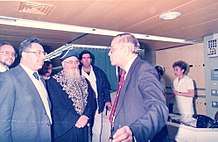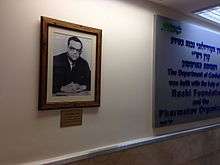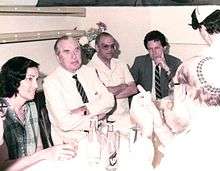Moshe Gueron
Moshe Yitzhak Gueron (Hebrew: משה יצחק גרון; b. 20 March 1926 - 11 December 2017) was an Israeli physician and researcher, innovator, scientist, medical educator, Professor of Cardiology at the Medical School for International Health at Ben-Gurion University of the Negev, a pioneer in the field of Cardiology. He founded and managed the Division of Cardiology in the Soroka Medical Center for 30 years. His research and clinical works gained broad international recognition. Gueron played a central role in developing global medicine, and he is mainly known for his work on the treatment of heart patients with cardiovascular manifestations of severe scorpion sting.[1][2][3] Gueron was a protege of the late Prof. Noble O. Fowler, who invited him in 1958 to a University of Cincinnati fellowship in Cardiology.[4]
Moshe Gueron | |
|---|---|
Moshe Gueron | |
| Born | 20 March 1926 |
| Died | 11 December 2017 (aged 91) Beer Sheba, Israel |
| Education | Hebrew University of Jerusalem, University of Cincinnati, Soroka Medical Center, Hadassah Hospital Tel Aviv. |
| Known for | Performing the first successful Cardiac catheterization in Israel. First worldwide research about cardiovascular manifestations of severe scorpion sting. |
| Medical career | |
| Profession | Cardiologist and researcher |
| Institutions | Soroka Medical Center University of Cincinnati Hadassah Hospital Tel Aviv Donolo Hospital in Jaffa Tel Hashomer Hospital |
| Sub-specialties | Cardiovascular diseases |
Biography
Gueron was born in Sofia, Bulgaria to Bechora (née Castro) and Yitzhak Gueron. He attended a Catholic French college, but was sent to a transit camp by the Nazis in 1943. The Bulgarian government refused to permit the deportation of Bulgarian Jews, and by 1944, Prof. Gueron returned to Sofia and entered medical school at The University of Sofia. After Israel won independence in 1948, he emigrated from Bulgaria to Israel and lived in Jaffa with his parents.
In 1949 he joined the first medical school class of Hebrew University in Jerusalem. There he met his future colleagues and past friends from Bulgaria: Prof. Pascal Tiberin, who later founded the Department of Neurosurgery at Soroka Medical Center, Prof. Menachem Hirsch, who later founded the X-ray institute in Soroka Medical Center, Prof. Isaac (Izzy) Djerassi, a Philadelphia-based medical pioneer, researcher and clinician in the fields of hematology and oncology,[5] and Prof. Joseph Rosenfeld, who later became Golda Meir's and Zalman Shazar's private physician. Many of the graduates of the faculty of medicine of the Hebrew University in Jerusalem were immigrants from Bulgaria. Gueron graduated summa cum laude in 1951.

After his graduation, Gueron started his fellowship in internal medicine in Hadassah Hospital Tel Aviv and a few months later he already served as senior internal doctor. In 1956, shortly after his graduation in internal medicine, Gueron came to the conclusion that there is no future for him in internal medicine. Drawn by his conclusion he left internal medicine and in 1958 he turned to specialize in cardiology. He arrived to America to the school of medicine in University of Cincinnati at the invitation of Prof. Noble O. Fowler, who was widely considered the father of modern Cardiology.[6] Fowler served as the director of the division of cardiology in the department of internal medicine in the University of Cincinnati from 1970 to 1986, and professor emeritus at the same institution from 1984 to the time of his death (March 8, 2003) from prostatic carcinoma.
During his fellowship, Gueron received a scholarship from the American Heart Association to finance his studies.
Upon completion of his fellowship in cardiology in Cincinnati in 1961, Gueron was doubting about his return to Israel. However, he returned to Israel in 1961 and started working in Tel Hashomer Hospital under Prof. Henry Neufeld, knowing that professional future in the country is shrouded in uncertainty and the idea of coming back to United States or Canada did not go away, but his family and life circumstances caused him to remain in Israel.
Moshe Soroka, the then-general manager of Clalit Health Services who also founded the central hospital of the Negev, today Soroka Medical Center under his name, had received a recommendation from Prof. Aharon (Harry) Heller, the then-director of the department of internal medicine in Tel Hashomer Hospital, today Sheba Medical Center, about Prof. Gueron excellence and enthusiasm, only one year from the beginning of Gueron's and Heller's joint work within the Heart Institute in Tel Hashomer Hospital. Prof. Heller urged Moshe Soroka to bring Gueron to live in Beersheba and work in Soroka Medical Center where Heller thought Gueron contribution will be of the greatest benefit.
Return to Israel
One year after his return to Israel in 1961, Gueron indeed settled in Beersheba and received a job in Soroka Medical Center. Prof. Yosef Stern, Soroka's first director general supported Gueron's idea to establish a department of cardiology in the hospital. Two months after his arrival, Prof. Gueron has already started to perform heart catheterization in patients. Gueron is known for performing the first successful heart catheterization in Israel.
Prof. Gueron started to engage in cardiac muscle-related events in patients at the advice of Prof. Wilhelmina Cohen, the then-director and founder of Soroka's Pediatric Division, which while treating a young Bedouin boy who was stung by a deathstalker, discovered symptoms of shock, ventricular arrhythmias and ventricular tachycardia. This issue has evolved into a large-scale, great depth research by Prof. Gueron and his team, who were the first in the field of medicine to have found that yellow scorpion venom evokes potent cardiovascular responses in humans.[7] Gueron's work, his treatments in patients and studies on severity of scorpion stings were published in the largest medical publications on a global scale.[3][8][1]
Prof. Gueron was the only cardiologist in Soroka Medical Center, from his arrival to the hospital in 1962 until 1968, and the only cardiologist to provide with all cardiology-related treatments, including interventional cardiology.
Medical career

Gueron was appointed Professor at Soroka Medical Center in 1967, and was involved in the development of the techniques of heart and heart-lung treatment.[9] Gueron is best known for a research he has managed regarding the treatment of scorpion evenomation and its affection on the human's heart.[10] During his 40 years research, thousands of stung patients were reviewed. Gueron's research has shown that thirty-four patients with severe scorpion sting were reviewed and pertinent data related to the cardiovascular system such as hypertension, peripheral vascular collapse, congestive heart failure or pulmonary edema were analyzed.[11] The electrocardiograms of 28 patients were reviewed, 14 patients showed "early myocardial infarction-like" pattern. The urinary catecholamine metabolites were investigated in 12 patients with scorpion sting. Vanylmandelic acid was elevated in seven patients and the total free epinephrine and norepinephrine in eight. Six of these 12 patients displayed the electrocardiographic "myocardial infarction-like" pattern. Nine patients died and the pathologic lesions of the myocardium were reviewed in seven.[8] The anticipated time line is within three years depending on successful animal trials. Gueron was described hypertension, pulmonary oedema with hypertension, hypotension, pulmonary oedema with hypotension and rhythm disturbances as five different syndromes that may dominate the clinical picture in scorpion sting victim. He suggested that all patients with cardiac symptoms should be admitted to an intensive cardiac unit. Gueron was questioned regarding the value of giving antivenin, and he replied that although is freely available, all cases of scorpion sting are treated without it, and there had not been a single fatality in 1989.[12] In 1990, he reported poor contractility with low ejection fraction, decreased systolic left ventricular performance, lowered fractional percentage shortening observed in echocardiographic and radionuclide angiographic study.[12] In fact, Gueron's research tended to prove the irrelevance of antivenin in patients with severe scorpion sting.
Retirement

Gueron was employed by Soroka Medical Center from 1962 until 1992 and operated on more than 100,000 patients. Having retired from performing cardiology at the age of 67, he continued to act as a high-profile consultant, globally and locally.[9] Gueron is recognized as a world leader in heart research who worked with other fellow physicians as Sir Magdi Yacoub, Michael E. DeBakey, C. Walton Lillehei, Michel Mirowski, Prof. Natalio Krystal, Prof. Bernardo Vidne, Joseph B. Borman among others.[13] Gueron also treated world leaders and famous people including Kopel Gurwin, Boris Yeltsin, Miguel de la Madrid, Bill Clinton, Nikolai Ryzhkov, Daniel Edelman, Loel Guinness and William Lubtchansky. He published more than 300 full-length research papers in national and international journals.
Personal life
On December 11, 2017, Gueron passed away peacefully while in his sleep at his residence. He was survived by his wife Sofi and his two children. Eliyahu, his elder brother, who immigrated to Israel in 1944 and was among the founders of Kibbutz Urim, fought in The War of Independence, and fell in 1948 Battles of the Separation Corridor.
Prof. Gueron was a close friend of Prof. Eliahu E. Lehmann, Prof. Galinus Hoda, Israeli minister Aharon Uzan and Israel's 6th Police Commissioner Haim Tavori.
In 1975, Prof. Gueron and 12 other physicians arrived in Iran in order to teach local physicians about their findings in relation to cardiovascular manifestations of severe scorpion sting. During that trip Gueron was a special guest of Mohammad Reza Pahlavi who later became his good friend.
References
- Sofer, Shaul; Shahak, Eliezer; Gueron, Moshe (1994). "Scorpion envenomation and antivenom therapy". The Journal of Pediatrics. 124 (6): 973–978. doi:10.1016/S0022-3476(05)83196-8.
- Bawaskar, H.S (1999). Scorpion Sting: Clinical Manifestations, Management, and Literature. ISBN 9788171547180.
- Yarom, Rena; Gueron, M.; Braun, K. (1970). "Scorpion Venom Cardiomyopathy". Pathobiology. 35 (1–3): 114–117. doi:10.1159/000162209.
- "Archived copy". Archived from the original on 2016-05-29. Retrieved 2016-05-26.CS1 maint: archived copy as title (link)
- http://jewishexponent.com/isaac-djerassi,-pioneer-oncologist,-dies-at-86
- http://enquirer.com/editions/2003/03/15/loc_otherobit15.html
- Bawaskar, H.S (1999). Scorpion Sting: Clinical Manifestations, Management, and Literature. ISBN 9788171547180.
- Abroug, F.; Ouanes-Besbes, L.; Elatrous, S. (2009). "Antivenom for Children with Neurotoxicity from Scorpion Stings". New England Journal of Medicine. 361 (6): 631–632. doi:10.1056/NEJMc091264. PMID 19657132.
- Ilia, Reuben; Weizman, Shimon; Gueron, Moshe (1991). "Effects of rapid volume expansion on the right filling pressures after prosthetic valve surgery". Catheterization and Cardiovascular Diagnosis. 23 (3): 169–171. doi:10.1002/ccd.1810230304. PMID 1868526.
- Gueron, Mosche; Sofer, Saul (1991). "Scorpion envenomation". Chest. 100 (3): 883–884. doi:10.1378/chest.100.3.883b.
- Gueron, Mosche; Yaron, Rema (1970). "Cardiovascular Manifestations of Severe Scorpion Sting". Chest. 57 (2): 156–162. doi:10.1378/chest.57.2.156.
- Bawaskar, H. S. (1999-03-15). Scorpion Sting: Clinical Manifestations, Management and Literature. Sangam Books Ltd. ISBN 978-81-7154-718-0.
- "Archived copy". Archived from the original on 2012-02-23. Retrieved 2009-12-29.CS1 maint: archived copy as title (link)
Publications
- Gueron, Mosche; Yaron, Rema (1970). "Cardiovascular Manifestations of Severe Scorpion Sting". Chest. 57 (2): 156–162. doi:10.1378/chest.57.2.156.
- Sofer, Shaul; Weinhouse, Elliott; Tal, Asher; Wanderman, Kenneth L.; Margulis, Giora; Leiberman, Alberto; Gueron, Moshe (1988). "Cor Pulmonale Due to Adenoidal or Tonsillar Hypertrophy or Both in Children". Chest. 93: 119–122. doi:10.1378/chest.93.1.119.
- Gueron, Mosche; Ilia, Reuben; Margulia, Giora (2000). "Arthropod poisons and the cardiovascular system". The American Journal of Emergency Medicine. 18 (6): 708–714. doi:10.1053/ajem.2000.9265.
- Ilia, Reuben; Rosenshtein, Gabriel; Marc Weinstein, Jean; Cafri, Carlos; Abu-Ful, Akram; Gueron, Mosche (2001). "Left anterior descending artery length in left and right coronary artery dominance". Coronary Artery Disease. 12: 77–78. doi:10.1097/00019501-200102000-00011.